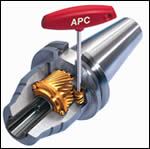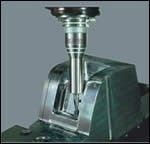Get A (Tight) Grip
High toolholder gripping torque reduces the likelihood that a tool will slip within a toolholder during a cutting operation. A mechanical toolholder design provides a very high gripping torque via a worm gear that compresses a shallow-taper collet tightly around a tool shank.
Share




Do you have any idea how much gripping torque your toolholders exert on cutting tools? Feedback received by Tom Sheridan, director of marketing for Albrecht, suggests that most shops understand the importance of high toolholder gripping torque, but they usually don’t know exactly how much torque their toolholders produce.
High tool gripping torque reduces the likelihood that a tool will slip within a toolholder during a cutting operation. This can enable more aggressive cuts and faster speeds and feeds. At the same time it increases overall system rigidity, extending cutting tool life and improving workpiece surface finish. These are reasons why shops have traditionally used hydraulic and shrink-fit toolholding systems. Hydraulic toolholders work by uniformly compressing fluid within a chamber around a tool’s shank. Shrink-fit systems use a heating element to slightly expand a toolholder’s inner diameter to accept a tool shank. Then the toolholder body cools around the installed tool and creates an interference fit that secures the tool.
Mr. Sheridan says Albrecht’s APC toolholding concept provides higher gripping torque than both of those methods. For a 0.5-inch-diameter tool, an APC toolholder delivers 1,700 inch-pounds (200 Nm) of torque, which Mr. Sheridan says is 95 percent higher than some hydraulic toolholder designs.
The APC’s internal components are shown in the cutaway image above. Cutting tools install in a collet that has a proprietary coating to prevent tools from sticking during changeovers. An internal set screw allows accurate presetting of tool height. Operators then use a hex key to turn a worm gear which serves to compress the collet around the tool’s shank. Because the collet has a taper of only 1.5 degrees (3 degrees included), the tool is fixed both axially and radially. This provides the high gripping torque.
The APC system accommodates tool shank diameters ranging from 0.125 to 1.25 inches. It is compatible with tools that have interrupted shanks, which may not be the case when using hydraulic or heat-shrink toolholders, Mr. Sheridan notes.
In addition to standard and extended-length versions, the APC is available in a small-body-diameter model that provides tool clearance to reduce potential workpiece interference. (This is well-suited for moldmaking applications.) The APC’s design does not use a collet nut, which also improves tool clearance.
Mr. Sheridan suggests that shops use quality cutting tools with an H6 or better shank tolerance to avoid variation in tool shaft diameters. An undersized shank, for example, would force the collet to compress further than it would on a tool that has an accurate diameter. That could angle the gripping surface in relation to the tool, resulting in a thin ring of contact instead of full surface contact between the collet and tool shank. Mr. Sheridan also recommends that shops adhere to proper maintenance practices with each tool change. Wipers should be used to clean a toolholder’s inner taper prior to inserting new collets. The external surface of collets should be cleaned during each change as well.
Related Content
-
How to Troubleshoot Issues With Tool Life
Diagnosing when a tool is failing is important because it sets an expectation and a benchmark for improvements. Finding out why gives us a clue for how to fix it.
-
Making the Most of Mixed Toolholder Assemblies
While nearly all ER systems will have cross compatibility, they’ll have small differences across manufacturers that make their implementation at the shop level not as standard.
-
How to Mitigate Chatter to Boost Machining Rates
There are usually better solutions to chatter than just reducing the feed rate. Through vibration analysis, the chatter problem can be solved, enabling much higher metal removal rates, better quality and longer tool life.



























